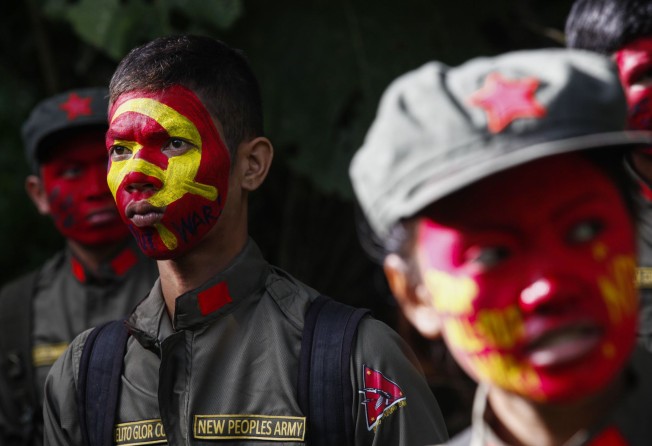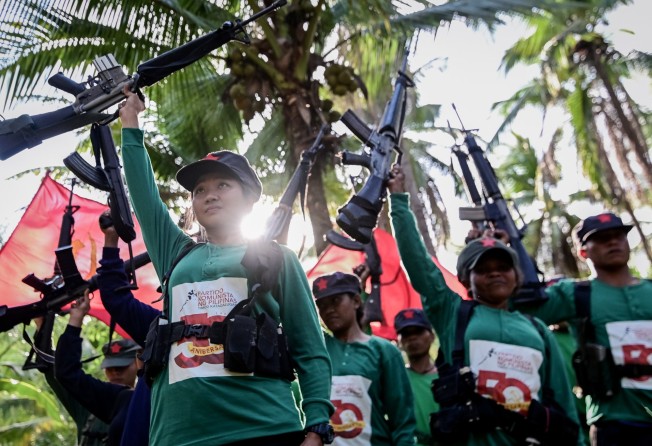
Philippine children of uniformed officers targeted as ‘easy prey’ by communists seeking to infiltrate security agencies
- By recruiting and radicalising children of army and police officers, the Communist Party of the Philippines (CPP) hopes to gain full access to the country’s security agencies
- CPP insurgents and followers were labelled ‘terrorists’ by the previous Duterte government, and new President Marcos has yet to declare if he will hold peace talks with them

The children of Filipino military and police officers have for decades been “easy targets” for radicalisation and recruitment by the Communist Party of the Philippines (CPP) and its armed wing, say experts, as concerns grow over the organisation deemed one of the country’s “most serious” security threats.
Communist rebels have waged an armed insurgency against Manila for more than five decades, and the targeting of children of uniformed officers has been a way for the CPP to gain access to all branches of the Philippines’ security agencies, says Mimi Fabe, a professor in financial terrorism and transnational organised crime at the Philippine National Police College.
Communist fighters also attempt to radicalise those children “so that they can sow divisions” within family members of the law enforcement, said Fabe, who has spent 10 years researching the recruitment of youth and children in areas across the Philippines where communist insurgents have launched attacks.
“The children of the police and military have a middle-class upbringing, and they are well-educated. They can use these children to spread the communist propaganda among their classmates and their friends since they deal with intellectuals,” she said.

Fabe cited Philippine author and journalist Joan Andrea Toledo as an example. In her book Crossing the Red Line, Toledo wrote that her father Antonio Lim Toledo and her uncles were allegedly “targeted” for recruitment when they were young, “because they were children of an Airforce officer”.
Toledo’s father and his brothers had access to all military and police camps and installations across the country.
Fabe said it was expected of children from army or police families to follow in the footsteps of their parents and become future leaders. “Thus, if they recruit the children, they can have access to the future leaders of the military and the police. They can have access to all the branches of the armed forces.”
She added that communist groups also wanted to benefit from the kinship and strong “brotherhood network” within the military and the police, where the camaraderie “is tight and unbreakable”.
If necessary, they can kill a family member or their parents ... The philosophy of the CPP is that the party is above one’s family
The targeting of children for recruitment by communists started sometime in 1968, Fabe said. She estimated “a few hundreds of youths and children” had been recruited since.
They were tasked to carry out a range of duties, including fighting the military and government-linked forces, engaging in propaganda and radicalisation activities, providing medical services and gathering intelligence, Fabe said.
“Some of them died in the mountains when they were fighting against the Philippine military on behalf of the communist groups,” she said.
“If necessary, they can kill a family member or their parents to show their undivided loyalty for the Communist Party,” said Fabe. “The philosophy of the CPP is that the party is above one’s family.”

A report titled Situating the Role Schools Have Played in the Mindanao Conflict, published last month by the Singapore-based ISEAS-Yusof Ishak Institute, said the New People’s Army (NPA) – the armed wing of the CPP – recruited young people from some Philippine universities and schools to participate in their terrorist activities which include taking up arms, kidnapping, drug trafficking, and extortion.
Jonamari Kristin Floresta, Vice-President of ABC Educational Development Center Inc., Philippines, wrote in the report that a former member said 90 per cent of NPA’s cadres had been recruited from schools and universities, and that recruitment usually started through “legal organisations” infiltrated by communists.
“NPA patterns its armed struggle to China’s Maoist movement, and seeks to overthrow the current Philippine government and replace it with a new people’s democratic state led by the working class,” wrote Floresta.
The NPA is believed to use alternative learning schools in Mindanao provinces as a front to indoctrinate indigenous tribes with subversive ideas, and provide them with military training so they can contribute to the communists’ mission, said the report.
Fabe said the first point of radicalisation was to teach these youth that “there is no God”.
“Or at least they make them become agnostics. Once belief in God is gone, then one can do anything without having some sense of accountability,” she added.
The typical radicalisation effort involved offering several Marxist classes and propaganda material to these youth and children, she said. There were also some cases of recruitment via Facebook, WhatsApp and Instagram.
Fabe said children of armed personnel made for “easy prey” as their parents were stationed far away, often engaged in special operations. The parents often found out about their kids’ recruitment after they were arrested.
“Many of these officers are posted in different provinces of the archipelago which may result in physical separation from their children,” she said. “Thus, it is easy for the communists to target the children in their schools.”
Fabe said the recruitment of youths was “ongoing and the military is monitoring it well”.
In 2019, the Philippine armed forces estimated that the NPA had more than 5,000 fighters across the country.

Marcos’ new administration
On Monday, the Mindanao Times reported that newly-sworn in President Ferdinand Marcos Jnr had yet to declare if his administration would reopen talks with the CPP’s political wing, the National Democratic Front (NDF).
When the previous Duterte administration was elected, peace negotiations with the NDF resumed but a year later, Duterte called it off. His government later declared the CPP, NDF and NPA as “terrorists”.
Last week, CNN Philippines quoted CPP founding chairman Jose Sison as saying that the group was always open to peace negotiations with the Philippine government, no matter who the president was.
“It was Duterte who terminated the peace negotiations in 2017. But if the incoming Marcos administration is willing to talk, why not?” Sison was quoted as saying by CNN Philippines.
Sison reportedly noted the peace talks could not resume as the national government was still implementing an “all-out war” policy against the communist group.
Zachary Abuza, Professor of Southeast Asia at the National War College in Washington, said the NPA had a nationwide presence, with cells in every province.
In Mindanao, NPA’s stronghold was in the far east, but it has also been moving into the central regions, where there are large fruit plantations, Abuza said.
“While the NPA and the Moro Islamic Liberation Front (MILF) had a tactical accord for many decades, I wonder how durable it is as they are now vying for control and the hearts and minds of the lumads (indigenous community),” he said.
The MILF, another insurgent group, has signed a peace agreement with Manila but the full process has yet to be completed.
“Duterte squandered multiple opportunities to negotiate with the CPP and NPA. I don’t see that changing under Marcos,” said Abuza.
Fabe said the Philippine armed forces had identified the CPP, NPA and the NDF as the primary security threats of the country.
“I regard the communist threat ... as the most serious one, more than the Isis-linked groups, because they have been launching terrorist attacks such as arson and attacks on police and military,” she said.